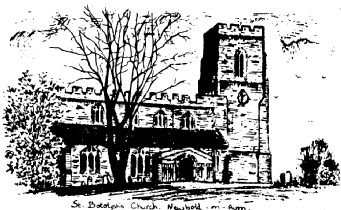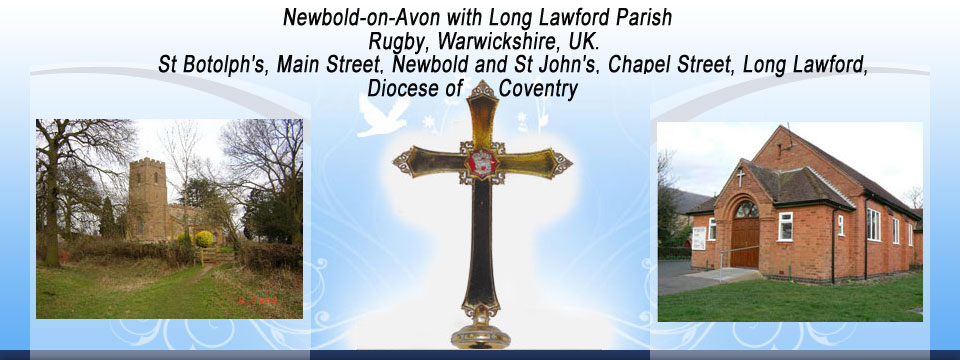St Botolph's Church, Newbold-on-Avon

The church of dates from the fifteenth century but it is built on the site of an earlier church. This can be seen from the exposed portion of early fourteenth century tiled floor near the chancel arch. The church consists of chancel, nave, north and south aisles, north and south porches and a west tower. The building is constructed mainly of red sandstone with some limestone rubble.
A Tour of the Church.
The North door is original and dates from the fifteenth century, (circa 1455). On the doors are three tablets carved with names, in abbreviated form, of the churchwardens who were in office when the doors were erected - Thomas Webbe, Thomas Boughton and William Boughton. On the outside of the porch are four big canopied niches, which originally held four statues of saints. It is assumed that these were removed by the Puritans. The porch is in the Perpendicular style of architecture.
The North Aisle contains three stained glass windows all illustrating scenes from the bible but they are unusual in that they incorporate the faces of the people whom they commemorate in the inscriptions below each window.
At the East End of the North Aisle is a piscina recessed into the wall. This stone drain was made to take the rinsings from the communion vessels. It drained directly onto consecrated ground outside the church. The basin originally projected out from the wall but this was cut away during a restoration in the early 20th Century.
Here also is a set of three Houseling Benches of 1660, made at the time of the Restoration of the Monarchy for use in place of the communion rail, which had been destroyed by the soldiers of the Commonwealth army.
The Chancel is a Victorian reconstruction but it contains many features of the original chancel. The oak communion rails are Jacobean. The helmet and sword on the south wall are now acknowledged to be real armour, not just poorly made funereal armour. The crest is that of the Boughton family.
On the north wall the monuments include one to Sir Egerton Leigh, Bart., who founded the Baptist Chapel in Rugby and conducted open-air services in this area.
The large monument on the south wall is by John Hunt of Northampton and is believed to have been sculpted by Michael Rysbrack from portraits by Sir Godfrey Kneller. Dated 1716, it depicts Sir William and Dame Catherine Boughton. Sir William was a member of Queen Anne’s parliament.
The monument incorporates an eighteenth century optical illusion. If you stand directly opposite the monument and look at the central urn and then let your eyes run up and down the spiral carvings, out of the corners of your eyes the chests of the statues appear to move as if they are breathing.
Beneath this monument is the oak Parish Chest, used in the seventeenth century to store the church plate and valuables and the parish registers. It had four locks, all different, and could therefore only be opened when all four keyholders were present. The keys were held by the Vicar and the churchwardens. One of the locks was obviously inserted at a later date than the other three and it is assumed that the keyholder for this lock was the Poor Law Commissioner for Long Lawford. (See the “Charity Board” at the West End of the south aisle).
The oak pulpit dated from 1909 contains “linenfold” panelling from an earlier pulpit.
In the south pillar of the chancel arch is a small doorway and spiral stone staircase which led up to the rood loft on top of the screen which divided the chancel from the nave. This screen was destroyed by fire many years ago.
Behind the lectern at the base of the chancel arch on the south side, some of the floor tiles of the early 14th century are exposed, some three inches below the present floor level.
In the South Aisle, the oldest monument in the church is the incised alabaster table tomb to Galfridus Allesley, who died in 1401, and Alianora his wife. This tomb was once in the nave, just in front of the present lectern, and was no doubt used by the villagers in the days when the nave was empty of pews or seats. This is almost certainly the reason for the ‘Graffiti’ in the form of squares for the playing of “Nine Men’s Morris”, a game not unlike our present day noughts and crosses.
On either side of this tomb are two other alabaster monuments decorated in colour. The one on the left is a monument to Edward Boughton (died 1548) and his wife Elizabeth Boughton who died in 1583. She was related to William Sheldon of Barcheston of ‘The Sheldon Tapestries’ fame.
A similar monument on the right commemorates Edward Boughton (died 1625) and Elizabeth Boughton (died 1619) together with their son William (died 1635) and his wife Abigail who died the following year.
Under the arch in the south wall is a table tomb of Thomas and Elizabeth Boughton dated 1454. Almost certainly this arch tomb indicates that those whom it commemorates were responsible for the re-building of the church at that time. The tomb was for many years covered by a seat and is therefore in very good condition. The inscription is a thought for all:-
“Whoever you are who pass by, stop, read and lament.
I am what you will be, I have been what you are.”
The Caldecott monuments of the nineteenth century are also on the south wall, as is a list of the Vicars of Newbold, on the left of the vestry door. It will be seen that the Reverend Theodosius Egerton Boughton Ward Boughton-Leigh was the vicar for 50 years, dying in 1902 at the age of 79. Another line of note in the ministry at Newbold - the Parkers - provided three John Parkers as Vicars in succession from 1742 to 1852.
The South Porch is now used as the vestry but it was originally the entrance from Long Lawford. In the less enlightened times of the 19th century and the early years of the 20th century, the parishioners from Long Lawford used only this entrance and sat only on the south side of the nave whilst the parishioners from Newbold used the north door and sat on the north side of the nave! Thankfully those times have passed, although at an Induction Service in 1990 one person from Newbold, when shown to a seat on the south side refused it!
The ceiling of the south porch is stone vaulted and still shows faint traces of the gilding with which it was covered in the fifteenth century.
The Font at the West End of the nave is lead lined and is of the fourteenth century. It was part of the church that was on this site before the present building. However, the stonework was redressed in the nineteenth century.
The Organ was originally installed in a gallery above its present position in 1858. In 1909 the gallery was taken down and the organ moved to a new position at the West End of the south aisle. In 1978 the rear pews of the church were removed and the organ was moved to its present position.
The Tower and the Bells. There is a ring of 10 bells in the tower. Five of the bells were re-cast by John Briant of Hertford in 1792. Another was the gift of the Rev. J. Onley at that time. Two further bells were cast in 1977 to commemorate the Queen’s Silver Jubilee and were hung in 1978. Two more bells were added in 1992 to commemorate the 200th anniversary of the hanging of the bells in 1792.
The Clock is by Samuel Dalton of Rugby and is dated 1795.
Among the Church Plate are a silver flagon of 1708, the gift of Sir William Boughton, bart.; a silver alms dish dated 1703, the gift of Dame Catherine Boughton, and a chalice dated 1732.
In the Churchyard, not far from the small chancel door, ‘the priest’s door’, there is a gravestone in memory of John Norman Senr. His date of death is recorded as 174¾. This was caused by a change in the calendar in the eighteenth century. By one system February 13th was 1743 and by another it was 1744. New Years Day in the ‘old’ calendar was on March 25th.
The Weathervane on the tower was erected in the 1970’s and shows St. Botolph carrying the cross of Christ to proclaim the Gospel on his journeys, and leading his pack-donkey.

As you stand on the churchyard path facing the road you can see a hollow in the turf crossing diagonally beyond the flower bed. This is the line of the old tunnel of the Oxford Canal. The bricked up entrance to the tunnel can be seen over the hedge to the west of the tower. The hollow was formed by subsidence following the exceptionally dry summer of 1976.
Saint Botolph has been honoured as the Patron Saint of sailors and of agricultural workers but he is more especially recognised as the Patron Saint of travellers, and churches with his dedication were often built at city and town gates, where people would go to pray for a safe journey, or to give thanks for having just made one. (The London churches are at Aldgate, Bishopgate Without and Aldersgate. A fourth at Billingsgate was destroyed in the Great Fire of London.)
May you go forth from this house of God in peace and have a safe journey.
The Collect for St. Botolph’s Day
O God, by whose grace the blessed Abbot Botolph, enkindled with the fire of your love, became a burning and a shining light in your church; grant that we may be inflamed with the same spirit of discipline and love, and ever walk before you as children of the light, through Jesus Christ our Lord. Amen.
This History was written by Arthur Webster
